Glenrothes
| Glenrothes | |
| Scottish Gaelic: Gleann Ràthais | |
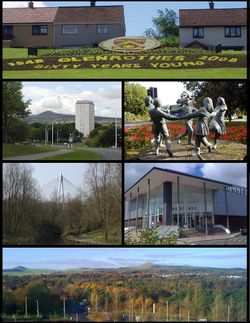 Images of Glenrothes |
|
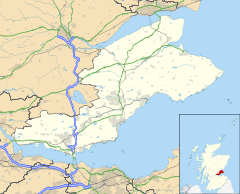 Glenrothes
|
|
| Area | 8.6 sq mi (22 km2) |
|---|---|
| Population | 38,927 [1] |
| - Density | 4,526 /sq mi (1,747 /km2) |
| OS grid reference | |
| - Edinburgh | 32 mi (51 km) |
| - London | 444 mi (715 km) |
| Council area | Fife |
| Lieutenancy area | Fife |
| Country | Scotland |
| Sovereign state | United Kingdom |
| Post town | GLENROTHES |
| Postcode district | KY6, KY7 |
| Dialling code | 01592 |
| Police | Fife |
| Fire | Fife |
| Ambulance | Scottish |
| EU Parliament | Scotland |
| UK Parliament | Glenrothes |
| Scottish Parliament | Central Fife, Mid Scotland and Fife |
| List of places: UK • Scotland • | |
Glenrothes (Scottish Gaelic: Gleann Ràthais[2]) is a large town situated in the heart of Fife, in east central Scotland. It is located approximately 30 miles (48 km) from both Edinburgh and Dundee.
Planned in the late 1940s as one of Scotland's first new towns, Glenrothes is the administrative capital of Fife containing both the Fife Council and Fife Constabulary headquarters. It was a major industrial centre in Scotland's Silicon Glen during the 1980s and 1990s with several major electronics and hi-tech companies establishing in the town. Glenrothes is unique in Fife as the majority of the town's centre is contained indoors, within Fife's largest indoor shopping centre - The Kingdom Shopping Centre.
According to a 2006 population estimate, Glenrothes is Fife's third largest town with a population of 38,927.[1] The Glenrothes conurbation, which includes the surrounding villages of Leslie, Markinch, Thornton and Coaltown of Balgonie has a population of 47,359.
The town has parks and landscaping recognised at the National level as being outstanding with Glenrothes winning multiple awards in the "Beautiful Scotland" contest.[3] It also has numerous outdoor sculptures and artworks, a result of the appointment of town artists in the early development of the town. Public facilities include a regional sports centre, civic centre with theatre, religious institutes and educational institutions including a college campus. The town has strong links with the main Scottish transport network.
Contents |
History
Glenrothes was designated in 1948 under the New Towns (Scotland) Act 1946 as Scotland's second post-war new town.[4][5] The name Rothes comes from the association with the north-east Scotland Earl of Rothes, family name Leslie. The Leslie family owned much of the land historically. Glen (Scottish for valley) was added to prevent confusion with Rothes in Moray, and because the town lies on the Leven valley.[6][7][8][9][10]
The original town plan was to build a new settlement for a population of 32,000–35,000 people. The intention of the new town for the developers was: "to establish a self-contained and balanced community for working and living".[11] The land where Glenrothes now sits was largely agricultural and once contained a number of small rural communities and the hamlets of Woodside and Cadham which were established to house workers at the local paper mills. Originally the new town was going to be centred on Markinch, however the village's infrastructure was deemed unable to withstand the substantial growth required to realise a new town.[6] Leslie and Thornton were also considered but as a consequence an area of 5,320 acres (2,153 ha) that sits between all of these villages was chosen.[12] The land taken was previously an area of great natural beauty. Balfour, Rothes, Aytoun and Balgonie estates were all incorporated in the Glenrothes designated area along with the historical stately homes, Balbirnie House, Leslie House and Balgeddie House.[13][14][15][16]
The planning, development, management and promotion of Glenrothes was the responsibility of the Glenrothes Development Corporation (GDC), a quango appointed by the Secretary of State for Scotland.[17] The corporation board consisted of eight members including a chairman and deputy chairman.[18] The first meeting of the GDC was in Auchmuty House, provided by Tullis Russell on 20 June 1949.[19][20]
The primary reason for the designation of Glenrothes was to house miners who where to work at a new super coal mine.[21] This was to be the most modern of the day and was built west of Thornton, an established village south of Glenrothes. The Super Pit was named the Rothes Colliery and it was officially opened by the Queen in 1957. About 5,000 miners were to be required to produce 5,000 tonnes of coal per day, and huge railway yards were established.[22] The pit was to have a working life of 100 years. The planned long-term benefits were to be huge, and the driver for economic regeneration for central Fife. At its peak the Rothes Colliery employed over 1,500 miners. In 1961, four years after opening, the huge investment was written off and the mine closed as a result of un-stemmable flooding and geological problems. Ironically, miners who had worked in older deep pits in the area had fore-warned against the development of the Rothes Pit for this very reason.[23] The closure of the state-of-the art facility left the huge enclosed concrete wheel-towers standing at Thornton for many years as a forlorn symbol of what could have been until demolished in the early 1990s.[24]
Originally the main industries in the Glenrothes area were paper-making (Tullis-Russell and the other mills along the Leven Valley), coal mining and farming. Unlike East Kilbride, Cumbernauld or Livingston Glenrothes was not originally to be a Glasgow overspill new town, although it did later take this role. It was however populated in the early 1950s in part by mining families moving from the West of Scotland and the declining Lothian coalfield areas.[23]
The pit's closure almost resulted in further development of Glenrothes being stopped. Shortly following this Central Government decided to change the town's role by appointing Glenrothes as one of the economic focal points for Central Scotland. The Glenrothes Development Corporation were successful in attracting a plethora of modern electronics factories to the town. The first big overseas electronic investor was Beckmans Instruments in 1959 followed by Hughes Industries in the early 1960s.[23] A number of other important companies followed establishing Glenrothes as a major hub in Scotland's Silicon Glen.[25] During the middle of the 1970s, the town also became the headquarters of Fife Regional Council, effectively the county town of Fife. Glenrothes officially took over the role from Cupar.[26][27][28]
Today, Glenrothes is the administrative centre of Fife. The town is considered to be a clean, generally well maintained and quietly successful modern town.[29][30] While much of the townscape consists of unexceptional 20th century developments, Glenrothes has many surprises. Early residential areas of Glenrothes present some of the best examples of post war social housing, two of which won Saltire Society Awards. Three of the towns earliest churches, St. Margaret's, St. Paul's and St. Columba's, are now listed buildings.[31][32] Glenrothes serves a wider area as both a service, employment and retail centre. There are a number of villages surrounding the town each unique in their own respect. The surrounding villages are Markinch, Leslie, Thornton, Coaltown of Balgonie, Star of Markinch, Milton of Balgonie (with Balgonie Castle) and Kinglassie. Slightly further afield are Falkland, Freuchie, Windygates, Kennoway, Muirhead, Auchmuirbridge and Scotlandwell.
The town has won awards for the Best Kept Large Town and the most Clean, sustainable and beautiful community in Scotland in the Beautiful Scotland competition [3] and a Silver Gilt award in the 2009 Britain in Bloom competition.[33]
Glenrothes also gained publicity by winning the 2009 Carbuncle Award, an unofficial contest operated by Urban Realm and Carnyx Group which was set up to criticise the quality of built environments in Scotland. Glenrothes was awarded the category of the most dismal place in Scotland for its depressed and investment starved town centre.[34] This generated mixed views from locals and built environment professions alike.[35]
Geography
Glenrothes lies in mid-Fife between the agricultural Howe of Fife in the north and east and Fife's industrial heartland in the south and west. Edinburgh and Dundee are located almost equidistantly from Glenrothes at 32 miles (51 km) and 27 miles (43 km) away, respectively. Its OS Grid reference is NO281015.
 |
Perth | Dundee | St. Andrews |  |
| Kinross | Leven | |||
| Dunfermline | Kirkcaldy | Firth of Forth |
The northern parts of the town lie upland on the southern fringes of the Lomond Hills Regional Park. The central parts of the town lie on land between the southern lip of the River Leven Valley, a green lung which passes east west through the town, and the Warout Ridge. Southern parts of Glenrothes are largely industrial and lie on land which gently slopes south towards the Lochty Burn and the village of Thornton.[29] The height above mean sea level at the town centre is 300 feet.[36] Temperatures in Glenrothes, like the rest of Scotland, are relatively moderate given its northern latitude. Fife is a peninsula, located between the Firth of Tay in the north, the Firth of Forth in the south and the North Sea in the east. Summers are relatively cool and the warming of the water over the summer results in warm winters. Average annual temperatures in Glenrothes range from a maximum of 18 °C (64 °F) to a minimum of 9 °C (48 °F).[37]
Townscape
Glenrothes' layout was based on an irregular grid. The first town masterplan sub-divided the designated area into self-contained residential precincts or areas with their own primary schools, local shops and community facilities.[38] The "precincts" were named after the hamlets already established (e.g. Woodside, Cadham), the farms which once occupied the land (e.g. Rimbleton, Caskieberran, Collydean) or historical stately homes in the area (e.g. Balgeddie, Balbirnie, Leslie Parks).[39] Separating industry as far as possible from housing areas in planned industrial estates was a key element of the plan.[40] This was a step change from the unplanned and polluted industrial towns and cities of the previous centuries where cramped housing and dirty industry were built in close proximity to one another. The idea for Glenrothes was to provide a clean, healthy and safe environment for the town's residents.[38] "Through traffic" would bypass housing precincts by a network of "Freeway" and "Highway" distributor roads which would connect each precinct to a purposely designed town centre and to the industrial estates.[41] A purposely designed pedestrian and cycle system was also created using a network of ring and radial routes.[41] Another element that was adopted was the use of roundabouts at junctions instead of traffic lights allowing traffic to flow freely.[41]

Around one third of land in Glenrothes has been devoted to the provision of open space.[42] Today as a result the town has numerous parks, the largest being at Riverside,[43] Balbirnie,[44] Warout, Gilvenbank,[45] Tanshall, Dovecot, Carleton[46] and Lochty Pond. The Lomond Hills Regional Park fringes and enters the town to the north and east.[47] Landscaping around the town has included the blending of housing into the northern hillside through the use of structural planting and tree belts.[42] Today a linked network of semi-natural landscape areas allow for a mix of biodiversity with different flora and fauna and wildlife habitats[48][49] Landscape areas also act as natural drainage systems, reducing the likelihood of flooding in the built up areas of the town, with rainwater flows channelled to the River Leven, or to the Lochty Burn.[42] Careful landscape planning has also ensured that Glenrothes' road network, with particular focuses on the town's many roundabouts, has been creatively landscaped creating green networks throughout the town.[48][49]
At first Glenrothes developed in a linear fashion starting at Woodside in the east and progressing westwards. Housing was a mixture of low-rise mixed housing and flats. A private estate was developed at Alburne Park for GDC managers.[50] The first masterplan was implemented as far as South Parks and Rimbleton housing precincts.[23][51][52]
Early Glenrothes precincts, developed under the first masterplan, were based on Ebenezer Howard's Garden City principles and this is reflected in their housing styles and layouts.[17][23]
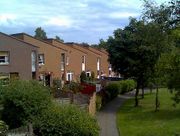
A second town masterplan was developed in the late 1960s following Glenrothes' change of role and was to accommodate an increased population target of 50,000-70,000. New areas of land in the north and south of the designated area were brought into production for new development.[53] The irregular grid layout was retained however housing precincts were to become less self-contained and would share local facilities in a new neighbourhood centre format.[54] The road network was to be upgraded to deal with projected increases in car ownership. New housing estates were developed to the west from Macedonia to Newcastle, to the south from Pitteuchar to Stenton and then to the north from Cadham to Collydean and Balfarg.[54] The precincts of the 1960s and 70's, developed under the second masterplan, were based on principles of Radburn, separating as far as possible footpaths from roads.[55] The townscape changed with a mixture of higher densities and more contemporary architectural styles. The fronts of houses were designed to face onto public footpaths and open spaces with car parking kept either to the rear of properties or in parking bays located nearby.[55]
Housing precincts from the 1980s onwards have largely been developed by the private sector and more reflect today's aspirations of low density suburban living.[29] The majority of this housing was developed as suburbs in the northern parts of the town at Balgeddie, Formonthills, Balfarg, Coul and Pitcairn, to the south at Finglassie, to the east at Prestonhall and Balbirnie and to the west at Whinnyknowe and Newcastle.[29][56] Glenrothes came late into high rise development and as a result it has only a single tower block, which is located adjacent to other tall buildings in the town centre. Three others were earmarked for the east of Pitteuchar backing onto the A92, but due to emerging problems associated with high rise blocks these were never built.[56] The townscape is largely low rise until the town centre is reached where flats and clusters of taller buildings have been used.[55]
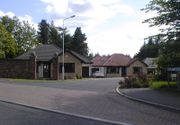
Large portions of land in the south of the town were developed for industrial purposes, largely as a result of the proximity to the proposed East Fife Regional Road (A92) which was developed in 1989 giving dual carriageway access to the main central Scotland road network. The second master plan was used until the wind-up of the Development Corporation in 1995.[57] The GDC left a lasting legacy on the town by overseeing the development of 15,378 houses, 480,692 square metres (5,174,125 square feet) of industrial floorspace, 68,328 square metres (735,476 square feet) of office floorspace and 53,603 square metres (576,977 square feet) of shopping floorspace.[4]
The development of Glenrothes since the demise of the GDC has been led by Fife Council's Development Plan. The emerging Mid Fife Local Plan, allocates land for the development of approximately 1,800 new houses in and adjacent to Glenrothes. It also outlines proposals for town centre renewal and for improvements to existing employment areas.[58]
Demographics
| Glenrothes | Fife | Scotland | |
|---|---|---|---|
| Total population | 38,679 | 349,429 | 5,062,011 |
| Foreign born | 1.04% | 1.7% | 3.8% |
| Over 75 years old | 5.1% | 7.46% | 7.1% |
| Unemployed | 5.2% | 3.97% | 4.0% |
Scotland's Census 2001 showed that Glenrothes has a population of 38,679. Recent population estimates show the population of Glenrothes in 2006 to be 38,927 showing a marginal increase compared with the 2001 census figure. The Glenrothes conurbation, which includes adjacent villages supports an estimated 47,359 people. The wider Glenrothes Area including the nearby villages of Star, Kinglassie and Milton of Balgonie supports an estimated population of 50,167.[1] The town also falls under the wider Mid-Fife Local Plan area which includes Kirkcaldy, Levenmouth, Cowdenbeath and Lochgelly having an overall total population of 180,220.[1]
The demographic make-up of the population is much in line with the rest of Scotland, with 30-44 year olds forming the largest portion of the population (23%). Despite the aging population in Scotland, Glenrothes has 2% fewer pensioners than the Scottish average.[61] Over 29% of the population in Glenrothes are in lower managerial and professional occupations which is a substantially higher proportion of people than both the Fife and Scottish averages.[62]
Governance
The designation of the new town of Glenrothes in June 1948, under the New Towns (Scotland) Act 1946, led to the secretary of state for Scotland appointing a development corporation.[18] The Glenrothes Development Corporation (GDC) set up as a "body corporate" to "secure the layout and development" of the new town of Glenrothes on 2,320 hectares of land from the lower slopes of East Lomond across the valley of the River Leven to north of Thornton.[4][18] The GDC with input from Fife County Council oversaw the governance of the new town until the wind up of the GDC in 1995.[4]
Today Glenrothes is represented by a number of tiers of elected government. North Glenrothes Community Council and Pitteuchar, Stenton and Finglassie Community Council form the lowest tier of governance whose statutory role is to communicate local opinion to local and central government.[63] Glenrothes now lies within one of the 32 council areas of Scotland. The town is the location of the headquarters of Fife Council. Council meetings take place in Fife House (formerly known as Glenrothes House) in the town centre. The west wing of the building was built by the Glenrothes Development Corporation (GDC) as their offices in 1969, which was later used as the headquarters of Fife Regional Council.[64] Since the last Scottish election in 2007, the council is jointly run by a Scottish National Party/Liberal Democrats coalition with 44 seats together.The councillor, Peter Grant was elected as leader of Fife Council.[65]
Glenrothes forms part of the county constituency of Glenrothes, electing one Member of Parliament (MP) to the House of Commons of the Parliament of the United Kingdom by the first past the post system. Lindsay Roy of the Labour Party is the MP for Glenrothes.[66] For the purposes of the Scottish Parliament, Glenrothes forms part of the Central Fife constituency. The Central Fife Scottish Parliament (or Holyrood) constituency created in 1999 is one of nine within the Mid Scotland and Fife electoral region. Each constituency elects one Member of the Scottish Parliament (MSP) by the first past the post system of election, and the region elects seven additional members to produce a form of proportional representation. The constituency is represented by Tricia Marwick, MSP of the SNP.[67] Glenrothes is also represented by seven regional MSPs from Mid Scotland and Fife electoral region.[68]
Economy
Glenrothes' economy is largely reliant on light industry and public sector jobs with moderate levels of construction, commercial office, retail and other service sector employment. Unemployment levels are slightly higher than the Scottish average, however the town provides the highest number of jobs (approx 36,000) and the largest net inflow of commuters when compared with any single settlement in Fife.[62] Fife Constabulary have established their headquarters at Viewfield. HM Revenue and Customs has a local office at Pentland Park, a business park within the town. The majority of shopping, commercial and administrative facilities in Glenrothes are concentrated in the town centre. This is bounded by a ring road, has been purposely planned, contains no residential element and the majority of shops and services are enclosed within a shopping mall. These are all factors which distinguish it from Fife's other town centres.
Fife's prominent local authority headquarters building is located at North Street in the town centre. Many of the other council departments are contained in a number of the town centre's office blocks.The Kingdom Centre forms the main shopping element containing approximately 100 shops as well as a variety of cafes, the town's central library, the Rothes Halls- the town's theatre, civic and exhibition centre and a ten pin bowling alley. The town's main bus station is located adjacent to the southeast end of the mall.[69] Extensions are proposed to the current shopping centre and proposals have been put forward to regenerate older parts of the centre at Albany Gate.[70] A new shopping park is also being built on the edge of the town centre to the north.[71]
Glenrothes has a number of neighbourhood shopping centres located at strategic points throughout the town. These contain parades of small shops and a variety of public facilities. The first of these to be built was the Woodside Centre. The Glenwood Centre, the Glamis Centre and the Cadham Centre followed as the town developed. A retail park has also been constructed at the Saltire Centre, located half a mile to the southwest of the town centre, which contains a number of warehouse store retailers.[17][23]
There are large concentrations of employment sites in the south of the town and at sites close to the town centre. Each estate has been named, these are: Bankhead, Westwood Park, Eastfield, Pentland Park, Queensway, Southfield, Viewfield and Whitehill[29]. Traditional industries are still existent in the area, with paper manufacturing being one of the town's largest employers. The Tullis Russell plant is the last operational paper manufacturer in Glenrothes following the closure of two smaller plants in the area. Paper manufacturing has operated from the site for over 200 years, pre-dating the designation of Glenrothes.[72] The current facility is made up by an anglomeration of two former mills; the Auchmuty Mill and the Rothes Mill.[73] Much of the company's expansion is owed to one of its former directors; David Russell.[74] The plant is in the process of developing a 50 megawatt biomass powerstation which will generate enough electricity to power the plant and the surrounding town.[75] In 2007 manufacturing accounted for around 20% of employment in Glenrothes.[62] A number of high tech industrial companies are located in Glenrothes largely specialised in electronics manufacturing.[29]
Semefab, a company based in Eastfield, is the UK's Primary Centre for the development of Micro Electric Mechanical Systems (MEMS) and Nanotechnology.[76][77]
Other major companies in Glenrothes include Raytheon (Defence), Brand Rex (fibre optics manufacturing), Velux (roof windows manufacturing), BI Technologies (electronics manufacturing), Compugraphics (photomask development), Regenersis (technology repair services), Bosch Rexroth (hydraulics manufacturing), FLEXcon (pressure-sensitive film manufacturing), Precision (precision engineering), Micronas (semi-conductor manufacturing), Virgin Media (call centre), Cullen Building Products (construction suppliers), and Amazon.co.uk (online retailer).[78][79]
Culture
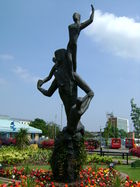
Glenrothes was the first Scottish new town to appoint a town artist in 1968.[80] Today, as a result, there is a large variety of artworks and sculptures scattered throughout the town made from a variety of materials such as bronze, fibre glass, bricks, sandstone and concrete. The sculptures range from giant flowers, giant hands, a dinosaur, toadstools, the Good Samaritan, a horse & chariot, dancing children, a seated old couple, crocodiles and marching hippos. The first sculpture erected in Glenrothes was Ex Terra, created by Benno Schotz.[80]
Landscaping in Glenrothes often leaves the impression that many of the housing areas have been built in parkland. The town has won numerous awards locally and Nationally for the quality of its landscaping.[3][33][81]
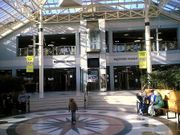
The Rothes Halls complex is the town's main theatre, exhibition, conference and civic centre venue. The complex caters for a large variety of regional and local events and performances including theatrical and musical performances and art exhibitions.[82] A community cinema operates from the Rothes Halls on weekends.[83] The town's central library and a cafe also form part of the Rothes Halls complex.[84]
There are a number of social clubs and organisations operating within Glenrothes which contribute to the cultural and community offerings of the town. These include an art club, various youth clubs, a floral art club, a local theatre company, a choral society and a variety of sports clubs.[85][86]
The town has a large variety of established sports facilities including two 18-hole golf courses (Glenrothes and Balbirnie), a football stadium at Warout and a major sports complex; the Fife Institute of Physical and Recreational Education (FIPRE).[42][87][88] The local football club is the Glenrothes F.C., a junior side who play at Warout Park. Glenrothes also has a rugby club based at Carleton Park and a cricket club who play at Riverside Park.[89][90] There are plans to build a new multi-million pound regional sports centre on the site of the existing Fife Institute beginning in early 2010.[91][92]
A war memorial was constructed in Glenrothes in 2007 following the deaths of two local Black Watch soldiers in Iraq. Prior to this Glenrothes was in the unusual position of not having a war memorial due to being a new town. Unlike traditional memorials, the Glenrothes war memorial consists of two interlinking rings of standing stones. As a result Glenrothes can now host its own Remembrance Sunday commemorations.[93]
![]() Glenrothes is twinned with Böblingen, a city in Baden-Württemberg, Germany, seat of Böblingen District.
Glenrothes is twinned with Böblingen, a city in Baden-Württemberg, Germany, seat of Böblingen District.
Landmarks & notable buildings
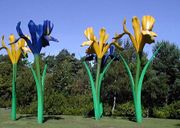
The most prominent landmarks in Glenrothes are the River Leven Bridge which towers over Riverside Park, the Tullis Russell factory chimneys towering in the east of the town, Raeburn Heights; a residential tower block and Fife House; an office block, both of which sit at the western corners of the town centre. These are the most recognisable tall structures in Glenrothes which can be seen from afar [94].
Glenrothes is home to the remains of ancient stone circles which can be seen at Balbirnie and Balfarg in the northeast of the town. A number of Glenrothes' artworks and sculptures act as landmarks at major gateways into the town, such as the Giant Irises at Leslie Roundabout, and the Glenrothes Gateway Totum at Bankhead Roundabout [29].
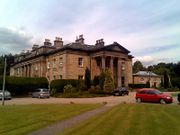
Balbirnie House, the category-A listed Georgian former home of the Balfour family, was bought along with its grounds in 1969 by the Glenrothes Development Corporation (GDC) from the Balfour family to be developed as Balbirnie Park and golf course.[95][96][97] The house was later occupied and restored by the GDC in 1981, to stop the property falling into disrepair. This led to potential interest and the house was converted into a four-star hotel in 1989. The former stable blocks of the house were also converted for use as a craft centre.[97] Balgeddie House, a former Victorian residence located in the northwest of the town, has also been converted into a high quality hotel.[13]
Leslie House, the category-A listed 15th Century former home of the Rothes family, became a care home for the elderly; owned by the Church of Scotland, and most recently is set to become luxury apartments. A fire destroyed the interior and roof of the house in late 2008 delaying the redevelopment.[98] Much of the former grounds of Leslie House have been used to create Riverside Park. Collydean precinct hosts a ruin of a 17th-century laird's house called Pitcairn House.[15]
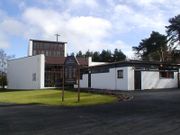
The town is also home to a number of churches which act as important landmarks as a result of their unique architectural styles and sometimes their locations at key road junctions. The three earliest churches are now listed buildings. These are St. Margaret's Church in Woodside (category C listed), St. Paul's RC Church in Auchmuty (category B listed), and St. Columba's Church on Church Street (category A listed) in the town centre.[31][32][99] St. Paul's RC was designed by architects Gillespie, Kidd and Coia[31][32][100] and has been described "as the most significant piece of modern church architecture north of the English Channel".[101] In 1993 it was listed as one of sixty key monuments of post-war architecture by the international conservation organisation DoCoMoMo. The church sits at a junction between two main distributor roads. St Columba's Church, designed by architects Wheeler & Sproson, has recently undergone significant restoration.[102][103] The church with its distinctive triangular iron bell tower and Mondrian inspired stain glass windows[104] acts as a landmark at the south-western gateway to the town centre.
There are two other gateway landmarks, located just outside Glenrothes. The B-listed Markinch Railway Viaduct marks the town gateway from Levenmouth in the east. This structure spans the River Leven Valley carrying the main East Coast rail line.[105]
To the west of Glenrothes is the B-listed Cabbagehall Railway Viaduct, which once carried a branch line connecting Leslie to Markinch over the River Leven Valley. This marks a main gateway entrance to Glenrothes from Leslie and now carries a major cycle/footpath, Böblingen Way, connecting Leslie with Glenrothes.[57][96]
Education
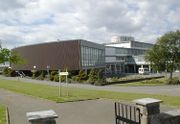
Early precincts in the town were served by their own primary schools which were to be provided on the basis of one school for every 1,000 houses.[106] The first primary school to be built in Glenrothes was Carleton Primary School in Woodside.[107] Warout Primary in Auchmuty followed and as development of the town progressed westwards further primary schools were developed to serve the central and western precincts such as those in Rimbleton, South Parks, Caskieberran and Newcastle.[107] The southern precincts were later served by both Pitteuchar East and Pittechuar West Primary Schools. Pitcoudie Primary School and Collydean Primary School, the last to be built in the town, were built to serve the northern precincts. St Paul's Primary School in Rimbleton was also built to serve catholic pupils in Glenrothes.[108] In total thirteen primary schools were developed in Glenrothes.[88][106]
Glenrothes also has three secondary schools. The earliest of these is Auchmuty High School which was opened in 1957, originally as a junior secondary. Secondary Schools were to be provided on the basis of one school for every 4,000 houses.[106] Glenwood High School was built in 1962 to serve the western precincts, also originally as a junior secondary. Prior to 1966 older pupils had to attend high schools in neighbouring towns to continue "Higher" examinations.[109] Glenrothes High School was the first "High School" built in 1966 to accommodate pupils at a "Higher" level. However changes in the education system nationally meant that both Auchmuty and Glenwood were extended and raised to full high school status in the 1970s.[110][111] Auchmuty High School serves the east and southern parts of Glenrothes as well as the villages of Markinch, Coaltown of Balgonie and Thornton.[112] Glenrothes High School serves the central and northern areas in the town.[113] Glenwood High School serves the western parts of Glenrothes and the villages of Leslie and Kinglassie.[114] Catholic pupils in Glenrothes attend St Andrew's High School in Kirkcaldy.[115] The Scottish Government and Fife Council have announced that a new Auchmuty High School is to be constructed by 2011.[116]
Further education in the town was once served by the former Glenrothes Technical College, built in the early 1970s, which specialised in paper manufacturing, mechanical engineering and electrical engineering. A second institute known as FIPRE (Fife Institute of Physical and Recreational Education) was built adjacent catering for sport and physical education as well as providing a sports centre for the town.[117] Today, Glenrothes is home to two campuses of the Adam Smith College.[118] The Adam Smith College was formed on the 1 August 2005 from the merger between the former Glenrothes College and Fife College, which was based in Kirkcaldy and is now Scotland's third largest college. The main campus of the college is located at Stenton Road in Viewfield to the south of the town centre. A smaller campus also exists within the Southfield Industrial Estate.[118] The Stenton Road Campus has been significantly extended in 2010.[119] New departments of Engineering, Construction, Renewables and Science have been created to cater for emerging industries specialising in renewables and low carbon technologies as well as provide training for major engineering projects.[120][121]
Transport
Glenrothes has direct dual-carriageway access to the M90 via the A92 Trunk Road. The A92 passes north/south through the town and connects Glenrothes with Dundee in the north and Dunfermline in the south where it merges with the M90. This gives Glenrothes a continuous dual-carriageway link to Edinburgh, although much of the route north to Dundee remains single-carriageway[105]. The A911 road passes east/west through the town and connects it with Levenmouth in the east and Milnathort and the M90 in the west.[105]
The town has a major bus station in the town centre which is adjacent to the Kingdom Shopping Centre.[122] Two railway stations - Glenrothes with Thornton railway station and Markinch railway station - serve the Glenrothes area. The former located in the village of Thornton, lies on the Fife Circle Line. The latter, located in Markinch, is the nearer to Glenrothes Town Centre (approx 1.5 miles (2 km)) lying on the Edinburgh to Aberdeen Line with services running between Edinburgh and Dundee as well as to Perth and Inverness via the Highland Main Line.[105]
Glenrothes is home to an airfield, Fife Airport (ICAO code EGPJ), which is used by Tayside Aviation to train pilots. The airport also caters to private light aircraft and contains a small restaurant.[123]
Edinburgh Airport is the nearest major airport to Glenrothes. It is within a 45-minute drive of the town and has regular flights to London, other UK cities and international international destinations in Europe and North America.[124] Dundee Airport operates daily flights to London, Birmingham and Belfast, and is within 40 minutes drive of the town.[125] The nearest ferry terminal to Glenrothes is located at Rosyth.[126]
References
Notes
- ↑ 1.0 1.1 1.2 1.3 "Population Estimates for Towns and Villages in Fife" (PDF). Fife Council. http://www.fifedirect.org.uk/uploadfiles/publications/c64_Population06Leaflet.pdf. Retrieved 2008-11-05.
- ↑ Mac an Tàilleir, Iain (2003) Placenames. (pdf) Pàrlamaid na h-Alba. Retrieved 23 March 2007.
- ↑ 3.0 3.1 3.2 "Beautiful win for Glenrothes". The Courier. 2008-09-18. http://www.thecourier.co.uk/output/2008/09/18/newsstory11977575t0.asp. Retrieved 2008-09-22.
- ↑ 4.0 4.1 4.2 4.3 Ferguson A New Town's Heritage: Glenrothes 1948-1995 p.7.
- ↑ Omand The Fife Book p.90.
- ↑ 6.0 6.1 Ferguson A History of Glenrothes pp.56–59.
- ↑ Ferguson A New Town's Heritage: Glenrothes 1948-1995 p.11.
- ↑ Cowling An Essay for Today - The Scottish New Towns 1947-1997 p.31.
- ↑ Omand The Fife Book pp.215–216.
- ↑ Wood 40 Years New Glenrothes 1948-1988 pp.15–19.
- ↑ Pride Kingdom of Fife p.80.
- ↑ Glenrothes Development Corporation Glenrothes - A Guide to Scotland's New Town in Fife p2
- ↑ 13.0 13.1 Glenrothes Development Corporation Glenrothes – New Town Master Plan Report pp14–15
- ↑ Ferguson A History of Glenrothes pp.30–31.
- ↑ 15.0 15.1 Ferguson, Keith (1996). A New Town's Heritage, Glenrothes 1948-1995. Glenrothes Development Corporation.
- ↑ Glenrothes Local Plan Proposals Map [1] Fife Council 2003-06-14. Retrieved on May 05, 2008
- ↑ 17.0 17.1 17.2 Cowling An Essay for Today – The Scottish New Towns 1947-1997 p.36.
- ↑ 18.0 18.1 18.2 Ferguson A New Town's Heritage – Glenrothes 1948-1995 p.23.
- ↑ Ferguson A New Town's Heritage – Glenrothes 1948-1995 p.25.
- ↑ Ferguson A History of Glenrothes p.62.
- ↑ Cowling An Essay for Today – Glenrothes 1948-1995 p.29.
- ↑ Glenrothes Development Corporation Glenrothes – A Guide to Scotland's New Town in Fife p.9.
- ↑ 23.0 23.1 23.2 23.3 23.4 23.5 Ferguson A New Town's Heritage:Glenrothes 1948-1995 pp.25–31.
- ↑ Cowling An Essay for Today – The Scottish New Towns 1947-1997 p.35.
- ↑ Cowling An Essay for Today – The Scottish New Towns 1947-1997 p.102.
- ↑ Ferguson History of Glenrothes pp.116–117.
- ↑ Ferguson A New Towns Heritage 1948–1995pp.89–90.
- ↑ Cowling An Essay for Today – The Scottish New Towns 1947-1997 p.34.
- ↑ 29.0 29.1 29.2 29.3 29.4 29.5 29.6 Cowling An Essay for Today – The Scottish New Towns 1947-1997 pp.45–47.
- ↑ Fegan, Bruce (2008-06-30). "Town Sparkling on Diamond Day". "The Courier". http://www.thecourier.co.uk/output/2008/06/30/newsstory11578965t0.asp. Retrieved 2009-07-02.
- ↑ 31.0 31.1 31.2 Ferguson A New Towns Heritage 1948-1995 p.61
- ↑ 32.0 32.1 32.2 Cowling An Essay for Today – The Scottish New Towns 1947-1997 p.41.
- ↑ 33.0 33.1 "Glorious Glenrothes celebrates special silver at 2009 Britain in Bloom awards". Fife Council. 2009-09-25. http://www.fifedirect.org.uk/yourtown/index.cfm?fuseaction=news.display&town=0F9DB065-BF8E-4BB7-85F9FB281784F80B&pageid=DDBC220A-E0A2-4984-787BD96B47E3AAD9&objectid=F02D47FB-F772-ED99-7B2D8122940E06E9. Retrieved 2009-10-25.
- ↑ "and the winner is...Glenrothes". The Carbuncle Awards 2009. 2009-05-04. http://www.thecarbuncles.co.uk/. Retrieved 2009-07-02.
- ↑ "'Depressed' town wins Plook award". BBC News Channel. 2009-01-29. http://news.bbc.co.uk/1/hi/scotland/edinburgh_and_east/7857781.stm. Retrieved 2010-05-14.
- ↑ Glenrothes Development Corporation Glenrothes - A Guide to Scotland's New Town in Fife p.12.
- ↑ "Annual Climate- Glenrothes, Scotland". UK Weather. http://uk.weather.com/climate/annualClimo-Glenrothes-UKXX0775. Retrieved 2009-03-17.
- ↑ 38.0 38.1 Glenrothes Development Corporation Glenrothes – A Guide to Scotland's New Town in Fife pp.2–3.
- ↑ Reid, Emma (2004). Old Glenrothes- Old buildings, farms and villages in the area which became the New Town of Glenrothes. Fife Family History Society.
- ↑ Glenrothes Development Corporation Glenrothes – New Town Master Plan Report p.37.
- ↑ 41.0 41.1 41.2 Glenrothes Development Corporation Glenrothes – New Town Master Plan Report pp.43–45.
- ↑ 42.0 42.1 42.2 42.3 Glenrothes Development Corporation Glenrothes – New Town Master Plan Report pp.97-98.
- ↑ "Riverside Park". Fife Council. http://www.fife.gov.uk/atoz/index.cfm?fuseaction=facility.display&town=0F9DB065-BF8E-4BB7-85F9FB281784F80B&facid=F5336D6E-0CD9-49B5-8B36AADD318C8C3D. Retrieved 2010-01-06.
- ↑ "Balbirnie Park". Fife Council. http://www.fife.gov.uk/atoz/index.cfm?fuseaction=facility.display&town=0F9DB065-BF8E-4BB7-85F9FB281784F80B&facid=D23E0CF5-1ACE-11D6-8DD600508BBD18A1. Retrieved 2010-01-06.
- ↑ "Gilvenbank Park". Fife Council. http://www.fife.gov.uk/atoz/index.cfm?fuseaction=facility.display&town=0F9DB065-BF8E-4BB7-85F9FB281784F80B&facid=B081D0A1-B540-0652-65D2D9515C74A1BB. Retrieved 2010-01-06.
- ↑ "Carleton Park". Fife Council. http://www.fife.gov.uk/atoz/index.cfm?fuseaction=facility.display&town=0F9DB065-BF8E-4BB7-85F9FB281784F80B&facid=0B150649-3C76-40BC-B37BA9A04E2BCA52. Retrieved 2010-01-06.
- ↑ "Lomond Hills Regional Park". Fife Council. http://www.fife.gov.uk/atoz/index.cfm?fuseaction=facility.display&town=0F9DB065-BF8E-4BB7-85F9FB281784F80B&facid=0B9472F0-DC3A-1AA0-2A86550980664908. Retrieved 2010-01-06.
- ↑ 48.0 48.1 Ferguson A New Town's Heritage: Glenrothes 1948-1995 p.61-62.
- ↑ 49.0 49.1 Cowling An Essay for Today – The Scottish New Towns 1947-1997 p.44-45.
- ↑ Glenrothes Development Corporation Glenrothes – A Guide to Scotland's New Town in Fife pp.4&10.
- ↑ Ferguson A History of Glenrothes pp.70–71.
- ↑ Ferguson A History of Glenrothes pp.84–87.
- ↑ Glenrothes Development Corporation Glenrothes - New Town Master Plan Report p.90.
- ↑ 54.0 54.1 Glenrothes Development Corporation Glenrothes – New Town Master Plan Report p.52.
- ↑ 55.0 55.1 55.2 Ferguson A New Town's Heritage – Glenrothes 1948-1995 pp36–38
- ↑ 56.0 56.1 Ferguson A New Town's Heritage: Glenrothes 1948-1995 p.38
- ↑ 57.0 57.1 Cowling An Essay for Today – The Scottish New Towns 1947-1997 pp36–38
- ↑ "Mid Fife Local Plan". Fife Council. http://www.fifedirect.org/topics/index.cfm?fuseaction=advicetopic.display&subjectid=F0F739ED-508B-DE79-47D3A6D0F83A12CD&objectid=2D40F6D8-AA48-7E7E-9FCFAD1A55B5820F. Retrieved 2010-04-19.
- ↑ "Comparative Employment Profile: Glenrothes Locality Scotland". scrol.gov.uk. 2001. http://www.scrol.gov.uk/scrol/browser/profile.jsp?profile=Employment&mainLevel=Locality&mainText=Glenrothes&mainTextExplicitMatch=false&compLevel=CountryProfile&compText=&compTextExplicitMatch=null. Retrieved 2010-01-12.
- ↑ "Comparative Population Profile: Glenrothes Locality Scotland". scrol.gov.uk. 2001. http://www.scrol.gov.uk/scrol/browser/profile.jsp?profile=Employment&mainLevel=CouncilArea&mainArea=Fife&mainText=&mainTextExplicitMatch=false&compLevel=CountryProfile&compText=&compTextExplicitMatch=null. Retrieved 2010-01-12.
- ↑ "Comparative Population Profile, Glenrothes Locality, Scotland". Scotland's Census- SCROL. http://www.scrol.gov.uk/scrol/browser/profile.jsp?profile=Population&mainArea=Glenrothes&mainLevel=Locality. Retrieved 2009-03-17.
- ↑ 62.0 62.1 62.2 "Glenrothes Economic Profile". Fife Council. 2007-04-14. http://www.fifedirect.org.uk/uploadfiles/publications/c64_GlenrothesRevisedApr07.pdf. Retrieved 2010-01-12.
- ↑ "Glenrothes-Local Representatives". Fife Council. http://www.fifedirect.org/yourtown/index.cfm?fuseaction=town.localreps&pageid=DDBC2238-A614-40FE-A55AE59CD9066494&town=0F9DB065-BF8E-4BB7-85F9FB281784F80B. Retrieved 2010-01-13.
- ↑ Ferguson A History of Glenrothes p.91.
- ↑ Meys, Lynsey (March 17, 2007). "SNP, Lib Dems control Council". The Fife Free Press. http://www.fifetoday.co.uk/news?articleid=2884083. Retrieved 2009-06-21.
- ↑ "Labour's Lindsay Roy wins Glenrothes by election". BBC News (Edinburgh, East and Fife). 2008-11-12. http://news.bbc.co.uk/1/hi/scotland/edinburgh_and_east/7724124.stm. Retrieved 2008-11-12.
- ↑ "Central Fife MSP info, Scottish Parliament". Scottish Parliament. http://www.scottish.parliament.uk/msps/locate/con-cfif.htm. Retrieved 2008-11-12.
- ↑ "Regional MSPs". scottish.parliament.uk. http://www.scottish.parliament.uk/msps/locate/con-east.htm. Retrieved 2009-12-31.
- ↑ "Glenrothes Town Centre Profile". Fife Council. 2006-05-20. http://www.fife.gov.uk/uploadfiles/publications/c64_GlenrothesTownCentreFS.pdf. Retrieved 2009-07-06.
- ↑ "Kingdom Centre extension". Shopping-centre.co.uk. 2007-06-11. http://www.shopping-centre.co.uk/news/fullstory.php/aid/1993/United_Kingdom.html. Retrieved 2009-07-06.
- ↑ "Glenrothes jobs boost as ASDA plan passed". Glenrothes Gazette. 2008-10-08. http://www.fifetoday.co.uk/glenrothes/Glenrothes-jobs-boost-as-Asda.4567000.jp. Retrieved 2009-07-06.
- ↑ "Tullis Russell Papermakers company info". Tullis Russell Papermakers. http://www.tullis-russell.co.uk/papermakers/. Retrieved 2010-08-01.
- ↑ Ferguson A History of Glenrothes p.47.
- ↑ "Local Heros- David Russell". Fife Council. http://www.fifedirect.org.uk/minisites/index.cfm?fuseaction=localhero.details&objectid=60&siteid=5B15B2E4-BFB4-7289-3816B182DD5811D8. Retrieved 2010-08-01.
- ↑ "RWE npower renewables signs Biomass plant deal". Tullis Russell Group. 2009-02-21. http://www.tullis-russell.co.uk/group/latest-news/show_press_content.cgi?title=RWE%20npower%20renewables%20signs%20Biomass%20plant%20deal. Retrieved 2009-12-27.
- ↑ "Semi-Scenic Secures Multi-system Deal Worth More Than $1 million". 2007-08. http://www.semiscenic.net/NewsSemefab.htm. Retrieved 2010-08-01.
- ↑ "Electronics Sector Profile". Fife Council. 2007-04-14. http://www.fifedirect.org.uk/uploadfiles/publications/c64_ufgcov.pdf. Retrieved 2009-07-24.
- ↑ "Internet Shoppers sweat it out in winter". The Courier. http://www.thecourier.co.uk/output/2009/12/24/newsstory14305887t0.asp. Retrieved 2009-12-24.
- ↑ "Fife Employment Land Audit 2006 – 2007". Fife Council. http://www.fifedirect.org.uk/uploadfiles/publications/c64_FinalEmploymentLandAuditReport.pdf. Retrieved 2009-07-24.
- ↑ 80.0 80.1 Ferguson A History of Glenrothes p.96.
- ↑ "Glenrothes in Bloom Newsletter". Fife Council. 2009-04-17. http://www.fifedirect.org.uk/news/index.cfm?fuseaction=news.display&objectid=B4978F7E-C577-087B-9DD8FA3288F370E4. Retrieved 2010-03-13.
- ↑ "Rothes Halls, Glenrothes". Fife Council. http://www.fife.org.uk/atoz/index.cfm?fuseaction=facility.display&ORGID=0310574C-E394-BE8B-9FB7EDEB350CC5F8&facid=009C6E9E-E931-4D2C-B3D21623F8B192F9. Retrieved 2010-05-14.
- ↑ "Glenrothes Community Cinema". http://www.glenrothescommunitycinema.co.uk/. Retrieved 2010-05-04.
- ↑ "Rothes Halls, Glenrothes". Arts & Theatres Trust, Fife. http://www.fifedirect.org.uk/attFife/index.cfm?fuseaction=org.FATFAC&contentID=009C6E9E-E931-4D2C-B3D21623F8B192F9. Retrieved 2009-07-17.
- ↑ "Your Town- Glenrothes". Fife Council. http://www.fifedirect.org.uk/yourtown/index.cfm?fuseaction=town.groups&pageid=DDBC2229-9380-91EE-5B5B25BB5DC7BBD2&town=0F9DB065-BF8E-4BB7-85F9FB281784F80B. Retrieved 2009-03-17.
- ↑ Ferguson A New Towns Heritage 1948-1995 p.71.
- ↑ Ferguson A New Town's Heritage:Glenrothes 1948-1995 pp.67-68
- ↑ 88.0 88.1 Cowling An Essay for Today – The Scottish New Towns 1947-1997 pp44–45.
- ↑ Ferguson A New Town's Heritage:Glenrothes 1948-1995 p.66.
- ↑ Ferguson A New Town's Heritage: Glenrothes 1948-1995 p.103.
- ↑ "Glenrothes Sports Centre". Cre8 Architecture. 2009-12-01. http://www.cre8architecture.com/projects/leisure-arts/glenrothes-sports-centre/. Retrieved 2009-12-21.
- ↑ "Cre8 and B3 win consent for Fife sport centres". Urban Realm. 2009-11-18. http://www.urbanrealm.co.uk/news/1919/Cre8_and_B3_win_consent_for_Fife_sport_centres_.html. Retrieved 2009-12-21.
- ↑ "New town finally has war memorial". BBC. 2009-10-22. http://news.bbc.co.uk/1/hi/scotland/edinburgh_and_east/7056813.stm. Retrieved 2010-08-01.
- ↑ Cowling An Essay for Today – The Scottish New Towns 1947-1997 p.43.
- ↑ "Course History". Balbirnie Golf Club. http://www.balbirniegolf.com/course-history.asp. Retrieved 2009-10-25.
- ↑ 96.0 96.1 Ferguson A History of Glenrothes p.19.
- ↑ 97.0 97.1 Ferguson A New Town's Heritage – Glenrothes 1948-1995 pp.64–66.
- ↑ "Leslie House, Glenrothes, Fife". Sundial Properties. http://www.sundialproperties.co.uk/current/index.php?ID=31. Retrieved 2009-03-17.
- ↑ "Scotland Building for the Future- Places of Worship pp.63–65". Historic Scotland. http://www.celebratingscotlandsarchitecture.org/scotland-building-for-the-future.pdf. Retrieved May 14, 2010.
- ↑ "Gillespie Kidd & Coia: St Paul’s, Glenrothes 1956". Willie Miller Urban Design. http://www.williemiller.co.uk/gillespie-kidd-coia-st-pauls-glenrothes-1956.htm. Retrieved May 15, 2010.
- ↑ Tricia Marwick (2001-05-16). "Scottish Parliament Official Report (Col735)- Architecture & the Built Environment". http://www.scottish.parliament.uk/business/officialReports/meetingsParliament/or-01/sor0516-02.htm#Col735. Retrieved 2009-07-24.
- ↑ "£1.1 million in lottery funds awarded to Scottish churches". Urban Realm. http://www.urbanrealm.co.uk/news/389/%c2%a31.1_million_in_lottery_funds_awarded_to_Scottish_churches.html. Retrieved August 25, 2009.
- ↑ "Scotland Building for the Future- Protecting our Heritage pp.96–97". Historic Scotland. http://www.celebratingscotlandsarchitecture.org/scotland-building-for-the-future.pdf. Retrieved May 14, 2010.
- ↑ "Scotland Building for the Future- Places of Worship p.65". Historic Scotland. http://www.celebratingscotlandsarchitecture.org/scotland-building-for-the-future.pdf. Retrieved May 14, 2010.
- ↑ 105.0 105.1 105.2 105.3 Cowling An Essay for Today – The Scottish New Towns 1947-1997 pp28–29
- ↑ 106.0 106.1 106.2 Glenrothes Development Corporation Glenrothes - New Town Master Plan Report p107.
- ↑ 107.0 107.1 Glenrothes Development Corporation Glenrothes – A Guide to Scotland's New Town in Fife p.4.
- ↑ "St Paul's RC Primary School". Fife Council. http://www.fifedirect.org.uk/atoz/index.cfm?fuseaction=facility.display&facid=84727D1B-1783-4776-B231D938B5BD0DF0. Retrieved 2009-12-15.
- ↑ Ferguson History of Glenrothes p75.
- ↑ Ferguson History of Glenrothes p.102.
- ↑ Ferguson A New Town's Heritage – Glenrothes 1948-1995 pp.45–46.
- ↑ "Auchmuty High School". Fife Council. http://www.fifedirect.org.uk/atoz/index.cfm?fuseaction=facility.display&facid=BD0D9353-3748-440F-8518CAEE45D88C9C. Retrieved 2010-07-27.
- ↑ "Glenrothes High School". Fife Council. http://www.fifedirect.org.uk/atoz/index.cfm?fuseaction=facility.display&facid=6C3C51A6-5395-46B7-BFD861DF50A321AF. Retrieved 2010-07-27.
- ↑ "Glenwood High School". Fife Council. http://www.fifedirect.org.uk/atoz/index.cfm?fuseaction=facility.display&facid=EA9528F5-0BE4-47DE-88D9DFCC8C62FE8B. Retrieved 2010-07-27.
- ↑ "St. Andrews High School". Fife Council. http://www.fifedirect.org.uk/atoz/index.cfm?fuseaction=facility.display&facid=97B6298C-418C-4F11-BCBE5F5909037A69. Retrieved 2010-07-27.
- ↑ "Fife's £1.25bn schools pot joy". The Courier. 2009-09-29. http://www.thecourier.co.uk/output/2009/09/29/newsstory13863575t0.asp. Retrieved 2009-11-29.
- ↑ Glenrothes Development Corporation Glenrothes - New Town Master Plan Report p108.
- ↑ 118.0 118.1 "Adam Smith College Campus Info". Adam Smith College, Fife. 2006-09-22. http://www.adamsmithcollege.ac.uk/general/location/default.aspx#stenton. Retrieved 2009-12-30.
- ↑ "Centre for Engineering, Construction, Renewables and Science: new building under construction". Adam Smith College, Fife. http://www.adamsmithcollege.ac.uk/physicalresources/buildings/underconstruction/centreforecrs/. Retrieved 2010-08-10.
- ↑ "MP Praises Adam Smith Commitment to Renewables". Adam Smith College, Fife. 2010-03-26. http://www.adamsmithcollege.ac.uk/relations/public/pressreleases/default.aspx?prid=20100326N01. Retrieved 2010-04-06.
- ↑ "New Adam Smith College building gets green light". Adam Smith College, Fife. 2008-12-02. http://www.adamsmithcollege.ac.uk/relations/public/pressreleases/default.aspx?prid=20081202N01. Retrieved 2009-07-17.
- ↑ "Glenrothes Bus Station info". Fife Council. http://www.fifedirect.org.uk/atoz/index.cfm?fuseaction=facility.display&facid=DD858BBB-9C3A-4A6E-B9C8577C5685608C. Retrieved 2010-01-04.
- ↑ "Fife Airport Information". Tayside Aviation. http://www.taysideaviation.co.uk/Fife/. Retrieved 2010-05-14.
- ↑ "Edinburgh Airport Information". The City of Edinburgh Council. http://www.edinburgh.gov.uk/internet/Transport/Public_transport/CEC_edinburgh_airport. Retrieved 2010-01-13.
- ↑ "Dundee Airport Information". Highlands & Islands Airports. http://www.hial.co.uk/dundee-airport.html. Retrieved 2009-12-30.
- ↑ "Rosyth Ferry Terminal". Fife Council. http://www.fifedirect.org.uk/atoz/index.cfm?fuseaction=facility.display&facid=51DF493B-B2D5-569A-EE7E490B67E6A9C6. Retrieved 2010-01-13.
Bibliography
- Ferguson, Keith (1982). A History of Glenrothes (1st ed.). Glenrothes: Glenrothes Development Corporation.
- Ferguson, Keith (1996). A New Town's Heritage: Glenrothes 1948-1995 (1st ed.). Glenrothes: Glenrothes Development Corporation. ISBN 0950260347.
- Cowling, David (1997). An Essay for Today: Scottish New Towns 1947-1997 (1st ed.). Edinburgh: Rutland Press. ISBN 1873190476.
- Wood, Alistair (1989). 40 Years New: Glenrothes (1st ed.). Glenrothes: Glenrothes Cheshire Homes.
- Omand, Donald (2000). The Fife Book. Edinburgh: Birlinn Publishing. ISBN 1841582743.
- Pride, Glen L. (1998). Kingdom of Fife (2nd ed.). Edinburgh: Rutland Press. ISBN 1873190492.
- Glenrothes and Surrounding Villages. Cupar: Links Media. 2006.
- Reid, Emma (2004). Old Glenrothes- Old buildings, farms and villages in the area which became the New Town of Glenrothes (1st ed.). Fife Family History Society.
- Glenrothes New Town Masterplan Report. Glenrothes: Glenrothes Development Corporation. 1972.
External links
- Glenrothes profile page, Fife Council
- Fife News
- Adopted Glenrothes Area Local Plan 2003, Fife Council